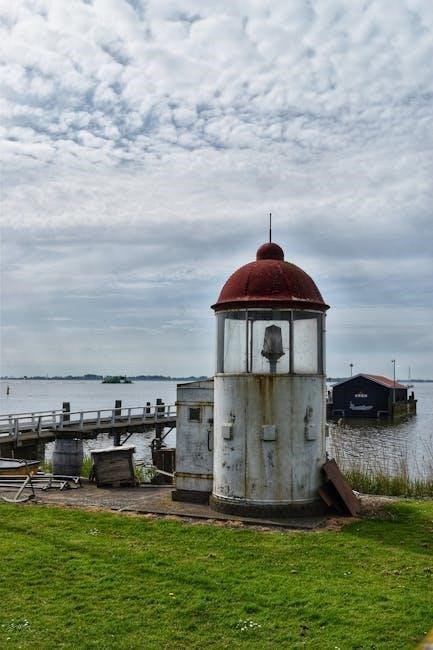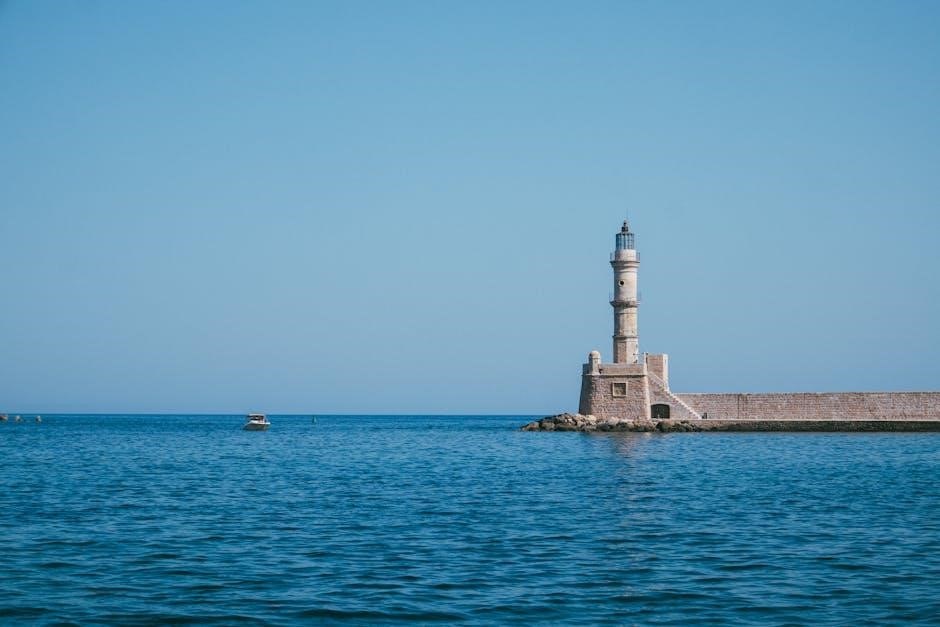Boat guide rollers are essential accessories designed to assist in aligning and centering a boat during loading and unloading on a trailer‚ enhancing safety and efficiency;
1.1 What Are Boat Guide Rollers?
Boat guide rollers are devices attached to a trailer‚ designed to assist in aligning and centering a boat during loading and unloading. Made from durable materials like polyurethane‚ rubber‚ or stainless steel‚ they provide a smooth surface for the boat to glide over‚ reducing friction and preventing damage to the hull. These rollers come in various types‚ including fixed‚ adjustable‚ and self-centering models‚ and are often paired with guide posts or brackets for enhanced stability. Their primary function is to guide the boat onto the trailer safely and efficiently‚ making the process easier for boat owners‚ especially in challenging conditions.
1.2 Importance of Guide Rollers in Boat Trailers
Guide rollers play a crucial role in enhancing the safety and efficiency of boat trailer operations. They simplify the process of loading and unloading by providing a smooth‚ guided path for the boat‚ reducing the risk of damage to the hull. Additionally‚ guide rollers improve trailer stability‚ ensuring the boat remains centered and secure during transport. They also protect the boat’s finish by minimizing friction and abrasion. Overall‚ guide rollers are essential for streamlining the boating experience‚ making it easier for boat owners to manage their vessels‚ especially in challenging conditions like shallow or fast-moving water.

Types of Boat Guide Rollers
Boat guide rollers come in various types‚ including fixed‚ adjustable‚ self-centering‚ and multi-roller systems‚ each designed to enhance loading efficiency and protect the boat’s hull.
2.1 Fixed Rollers
Fixed rollers are stationary guides attached to the trailer‚ providing consistent support during boat loading. They are durable‚ often made of rubber or polyurethane‚ and protect the hull from abrasions. Their simple design ensures easy installation and maintenance‚ making them a popular choice for smaller boats. However‚ they may not offer the flexibility needed for larger vessels or varying water conditions. Despite this‚ fixed rollers remain a reliable option for many boating enthusiasts seeking a straightforward‚ low-maintenance solution to simplify the loading process and enhance trailer stability.
2.2 Adjustable Rollers
Adjustable rollers offer versatility and adaptability‚ making them ideal for various boat sizes and trailer setups. These rollers can be tailored to fit different hull shapes and water conditions‚ ensuring a secure and centered alignment. Features like variable height and angle adjustments allow boaters to customize the setup for their specific needs. Constructed from durable materials such as stainless steel with non-marking rollers‚ they provide long-lasting performance. Their flexibility reduces the risk of hull abrasion and makes loading easier‚ especially in challenging environments. Adjustable rollers are a practical choice for boaters seeking a customizable solution to enhance their trailer’s functionality and ease of use.
2.3 Self-Centering Rollers
Self-centering rollers are a premium option designed to automatically guide the boat into the optimal position on the trailer. Unlike fixed or adjustable rollers‚ these units feature a spring-loaded mechanism that gently aligns the boat’s hull with the trailer’s centerline. This eliminates the need for manual adjustments and ensures a smooth‚ stress-free loading process. Constructed with durable materials like stainless steel and polyurethane‚ they offer excellent resistance to corrosion and wear. Their ability to adapt to various water conditions makes them ideal for frequent users seeking convenience and efficiency. Self-centering rollers are a worthwhile investment for those prioritizing ease and precision in boat handling.
2.4 Multi-Roller Systems
Multi-roller systems are advanced setups featuring multiple rollers that work together to provide superior support and guidance for your boat. These systems are particularly effective for larger boats‚ as they distribute the weight evenly and reduce pressure points on the hull. By utilizing several rollers‚ they enhance stability and minimize the risk of misalignment during loading and unloading. Multi-roller systems are also ideal for boats with unique hull designs‚ offering a customized fit and smoother transitions. They are a popular choice for boat owners seeking maximum durability and ease of use‚ ensuring a secure and hassle-free boating experience.

Benefits of Using Boat Guide Rollers
Boat guide rollers simplify loading and unloading‚ protect the hull from damage‚ enhance trailer stability‚ and save time‚ ensuring a seamless and efficient boating experience every time.
3.1 Ease of Loading and Unloading
Boat guide rollers significantly simplify the process of loading and unloading by providing a smooth‚ guided path for the boat onto the trailer. This reduces the need for constant adjustment and alignment‚ making the task less labor-intensive‚ especially in challenging conditions like shallow or fast-moving water. The rollers act as a centering aid‚ ensuring the boat is properly positioned every time‚ which minimizes the risk of damage to both the boat and the trailer. This ease of use is particularly beneficial for solo operators‚ allowing them to handle the boat with greater confidence and control‚ even in difficult situations.
3.2 Protection of the Boat Hull
Boat guide rollers play a crucial role in protecting the hull from damage during loading and unloading. Their smooth‚ non-marking surfaces prevent scratches and abrasions‚ while cushioned rollers absorb impact‚ minimizing wear and tear. By maintaining proper alignment‚ they reduce the risk of the boat shifting or rubbing against the trailer‚ which can cause costly repairs. Durable materials like polyurethane and rubber further ensure the hull remains unharmed‚ even in harsh marine environments. This protective function not only preserves the boat’s appearance but also maintains its structural integrity for years of reliable performance.

3.3 Enhanced Trailer Stability
Boat guide rollers significantly improve trailer stability by ensuring the boat is properly centered and aligned. This balanced positioning reduces wobbling and swaying‚ especially during transport on uneven terrain or at high speeds. The rollers’ smooth operation minimizes shifting‚ which can destabilize the trailer and lead to loss of control. By keeping the boat secure‚ guide rollers enhance overall towing safety‚ reducing the risk of accidents caused by trailer instability. This added stability also makes maneuvering the trailer easier‚ particularly in tight spaces‚ contributing to a safer and more confident towing experience for boat owners. Their role is vital for maintaining control and safety on the road.
3.4 Time-Saving Solution
Boat guide rollers offer a practical time-saving solution for boat owners. They simplify the loading and unloading process by providing clear alignment guidance‚ reducing the need for repeated adjustments. The rollers’ smooth operation allows the boat to glide into place effortlessly‚ even in challenging conditions like shallow or fast-moving water. This eliminates the frustration and time spent manually positioning the boat. With guide rollers‚ the process becomes faster and more efficient‚ enabling boat owners to spend less time on trailer setup and more time on the water‚ enhancing their overall boating experience.

Materials and Construction
Boat guide rollers are crafted from durable materials like polyurethane‚ rubber‚ and stainless steel‚ ensuring resistance to corrosion and wear. Non-marking cushioned rollers protect boat hulls.
4.1 Polyurethane Rollers
Polyurethane rollers are highly durable and resistant to abrasion‚ making them ideal for boat guide systems. They offer superior protection for the boat’s hull‚ preventing scratches and marks. Unlike rubber‚ polyurethane rollers maintain their shape under stress and are less likely to degrade over time. Their smooth surface ensures quiet operation and reduces friction during loading and unloading. Polyurethane rollers are also lightweight‚ corrosion-resistant‚ and easy to clean‚ making them a popular choice for marine applications. They provide long-lasting performance in harsh environments‚ ensuring a reliable and smooth boating experience.
4.2 Rubber Rollers
Rubber rollers are a popular choice for boat guide systems due to their ability to cushion the boat’s hull‚ reducing the risk of scratches and damage. They are non-marking and provide a quiet‚ smooth operation during loading and unloading. Rubber rollers are often larger in size‚ ranging from 9 to 12 inches‚ making them ideal for centering larger boats. Their flexible design allows for slight movement‚ accommodating various hull shapes. While durable‚ rubber rollers may wear faster than polyurethane‚ requiring occasional replacement. However‚ their protective qualities and ease of installation make them a practical solution for many boat owners.
4.3 Stainless Steel Frames
Stainless steel frames are highly durable and resistant to corrosion‚ making them ideal for marine environments. They provide strong support for guide rollers‚ ensuring stability and alignment during loading and unloading. These frames are constructed to withstand harsh conditions‚ including saltwater exposure‚ and are often paired with corrosion-resistant coatings for added protection. Their robust design ensures longevity and reliability‚ while also maintaining a clean‚ professional appearance. Stainless steel frames are a popular choice among boat owners due to their strength‚ durability‚ and ability to enhance the overall performance of the trailer setup.
4.4 Corrosion-Resistant Coatings
Corrosion-resistant coatings are applied to boat guide rollers to protect them from rust and degradation caused by exposure to water and salt. These coatings‚ often made from durable materials like galvanized layers or specialized polymers‚ ensure longevity and maintain the structural integrity of the rollers. They are particularly crucial in marine environments‚ where constant moisture and saltwater can accelerate corrosion. By preventing rust‚ these coatings help preserve the functionality and appearance of the guide rollers‚ reducing the need for frequent repairs or replacements. This enhances the overall performance and durability of the boat trailer system‚ ensuring reliable operation over time.

Installation and Maintenance
Proper installation and regular maintenance of boat guide rollers ensure smooth operation and longevity. Follow manufacturer guidelines for mounting and inspect rollers frequently for wear and damage.
5.1 Step-by-Step Installation Guide
Begin by gathering tools and ensuring the trailer is clean and dry. Mount the roller brackets securely to the trailer frame‚ typically using bolts. Align the rollers with the boat’s hull‚ adjusting their height and position as needed. Tighten all hardware firmly. Test the system by loading the boat to ensure proper alignment and smooth movement; Regular checks and adjustments will maintain optimal performance and prevent potential issues. Always refer to the manufacturer’s instructions for specific guidance tailored to your system.
5.2 Regular Maintenance Tips
Regular maintenance ensures longevity and optimal performance of boat guide rollers. Lubricate moving parts to prevent corrosion and friction. Inspect rollers for wear or damage‚ replacing them as needed. Clean debris from surfaces to maintain smooth operation. Check hardware for tightness and rust‚ applying corrosion-resistant coatings if necessary. Regularly inspect polyurethane or rubber rollers for cracks or degradation. Address issues promptly to avoid costly repairs. Proper upkeep ensures safe and efficient loading and unloading of your boat‚ extending the life of both the rollers and the trailer.
5.3 Repair and Replacement
Inspect guide rollers regularly for signs of wear‚ such as cracks or excessive friction. Replace polyurethane or rubber rollers when they show significant degradation. Check hardware for rust or looseness‚ tightening or replacing as needed. For severe damage‚ consider replacing the entire roller assembly. Use high-quality‚ durable materials to ensure longevity. If unsure about repairs‚ consult a professional. Timely replacement prevents further damage to the trailer or boat hull‚ ensuring safe and smooth operations. Always follow manufacturer guidelines for replacement parts to maintain compatibility and performance.

Choosing the Right Guide Rollers
Selecting the appropriate guide rollers involves considering boat size‚ trailer compatibility‚ weight capacity‚ and durability. Ensure they align with your boat’s hull type and trailer setup for optimal performance.
6.1 Considerations for Boat Size and Type
When selecting guide rollers‚ boat size and type are critical factors. Larger boats require sturdier rollers with higher weight capacities‚ while smaller boats benefit from lighter‚ more flexible options. Hull shape also plays a role—flat hulls may need different support than V-shaped or pontoon hulls. Additionally‚ the material of the rollers should match the boat’s finish to avoid damage. For instance‚ polyurethane rollers are ideal for delicate surfaces‚ while rubber or steel rollers suit heavier‚ more robust boats. Proper alignment ensures smooth loading and protects both the boat and trailer from potential damage.
6.2 Trailer Compatibility
Trailer compatibility is vital when choosing guide rollers. Ensure rollers fit your trailer’s frame size‚ height‚ and material. Adjustable rollers accommodate various boat sizes and trailer setups. Galvanized or stainless steel frames resist corrosion‚ ideal for saltwater use. Polyurethane rollers are durable and gentle on boat hulls. Consider weight capacity and ease of installation. Proper fit ensures smooth loading and unloading‚ protecting both boat and trailer. Always check manufacturer specifications for compatibility with your trailer’s make and model to ensure a seamless and safe boating experience.
6.3 Weight Capacity and Durability
Weight capacity and durability are critical factors when selecting boat guide rollers. High-quality rollers‚ often made from polyurethane or rubber‚ offer superior strength and resistance to wear. Stainless steel frames provide excellent corrosion resistance‚ ensuring longevity in marine environments. Ensure the rollers’ weight capacity matches your boat’s size to prevent damage or failure. Durable materials like non-marking polyurethane protect your boat’s hull from scratches. Brands like Fulton and C.E. Smith offer robust options designed for heavy use. Invest in rollers with rust-resistant coatings to withstand saltwater and harsh weather conditions‚ ensuring reliable performance for years of safe and efficient boat handling.
6.4 Brand and Quality Reputation
Choosing a reputable brand ensures durability and performance. Fulton and C.E. Smith are leading manufacturers‚ offering high-quality boat guide rollers with non-marking‚ cushioned designs. These brands provide rust-resistant coatings and sturdy constructions‚ suitable for various boat sizes. Their products are known for ease of installation and reliability in marine environments. Investing in trusted brands guarantees long-term efficiency and protection for your boat. Always consider customer reviews and warranties when selecting guide rollers to ensure you’re purchasing a durable‚ corrosion-resistant product that meets your boating needs and enhances your overall trailer setup’s performance and longevity.

Troubleshooting Common Issues
Troubleshooting common issues involves addressing misalignment‚ roller wear‚ and noise. Regular inspection and maintenance‚ such as tightening bolts and replacing worn parts‚ ensure smooth operation.
7.1 Alignment Problems
Alignment issues with boat guide rollers often arise from improper installation or bent frames‚ causing the boat to load unevenly. This can lead to difficulty in centering the boat‚ increased wear on rollers‚ and potential damage to the hull. Regular inspections and adjustments are crucial to ensure rollers are correctly aligned. Bent or warped frames should be repaired or replaced promptly. Additionally‚ checking for loose bolts and ensuring all components are securely fastened can help maintain proper alignment. Proper alignment not only enhances loading efficiency but also protects both the boat and the trailer from unnecessary stress and damage over time.
7.2 Roller Wear and Tear
Roller wear and tear is a common issue‚ often caused by frequent use‚ exposure to saltwater‚ and improper maintenance. Over time‚ rollers may crack‚ fade‚ or lose their grip‚ reducing their effectiveness. Signs include visible damage‚ difficulty in guiding the boat‚ and increased friction during loading. Regular inspection and cleaning can prevent premature wear. Replacing worn rollers with durable materials like polyurethane or rubber is recommended. Additionally‚ applying lubricants and ensuring proper alignment can extend their lifespan. Addressing wear promptly prevents further damage to both the rollers and the boat‚ ensuring smooth and safe loading operations every time.
7.3 Noise and Vibration
Noise and vibration during loading or unloading can indicate issues with guide rollers. Worn or misaligned rollers may rattle or vibrate‚ causing discomfort and potential damage. Regular lubrication of moving parts and ensuring proper alignment can minimize these problems. Durable materials‚ such as polyurethane or rubber‚ are less prone to vibration and noise. Additionally‚ securing rollers tightly and replacing worn-out components can help reduce unwanted movement. Addressing these issues promptly ensures smoother operation‚ protects the boat’s finish‚ and enhances overall trailer performance. Proper maintenance and high-quality materials are key to eliminating noise and vibration concerns.

Popular Brands and Their Offerings
Brands like Fulton and C.E. Smith offer high-quality boat guide rollers‚ featuring durable materials‚ non-marking surfaces‚ and easy installation‚ ensuring smooth boat loading and protection.
8.1 Fulton Boat Trailer Rollers
Fulton boat trailer rollers are renowned for their durability and functionality. Built with robust steel frames and cushioned‚ non-marking rollers‚ they provide smooth guidance for boat loading. Their bolt-on design ensures easy installation‚ fitting trailer frames up to 3×5 inches. Fulton rollers are ideal for various boat sizes‚ offering a reliable solution to center and protect the hull during loading. Their corrosion-resistant coatings ensure longevity‚ making them a trusted choice among boating enthusiasts seeking efficient and hassle-free trailer setups. Fulton’s commitment to quality enhances the overall boating experience with sturdy‚ long-lasting products.
8.2 C.E. Smith Guide-Ons
C.E. Smith Guide-Ons are highly regarded for their durability and effectiveness in boat trailer systems. Featuring smooth-rolling guides with multiple rubber rollers‚ they assist in centering the boat during loading‚ especially in shallow or fast-moving water. Constructed with corrosion-resistant materials‚ these guide-ons are designed to withstand harsh marine environments. They are compatible with various trailer setups and come with necessary hardware for easy installation. C.E. Smith Guide-Ons are a popular choice among boaters‚ offering reliable performance and enhancing the overall ease of loading and unloading. Their reputation for quality makes them a trusted option for boat trailer accessories.
8.3 Other Notable Brands
Beyond Fulton and C.E. Smith‚ other brands like Bass Pro Shops and Tiedown Engineering offer high-quality guide rollers. Bass Pro Shops provides durable‚ rust-resistant options with cushioned rollers‚ ideal for larger boats. Tiedown Engineering focuses on innovative designs‚ such as keel rollers and center guides‚ ensuring secure boat alignment. These brands emphasize ease of use‚ corrosion resistance‚ and compatibility with various trailer sizes. Their products are praised for enhancing loading efficiency and protecting boat hulls. With a range of styles and materials‚ these brands cater to different boating needs‚ ensuring reliable performance and longevity for boat trailer systems.

Accessories and Compatibility
Accessories like guide-on posts‚ brackets‚ and keel rollers enhance functionality. These components ensure compatibility with various boat and trailer sizes‚ improving overall performance and ease of use.
- Guide-on posts and brackets
- Keel rollers and center guides
- Additional hardware and parts
9.1 Guide-On Posts and Brackets
Guide-on posts and brackets are essential for aligning and securing your boat during loading. These durable posts‚ often made of stainless steel or galvanized metal‚ resist corrosion and withstand marine environments. Adjustable brackets allow customization to fit various boat sizes‚ while rollers or cushions on the posts protect the hull from scratches. They provide visual guidance and physical support‚ making the loading process smoother‚ especially in challenging conditions like shallow or fast-moving water. Compatible with most boat trailer systems‚ guide-on posts and brackets enhance safety and efficiency for solo or assisted loading scenarios.
- Durable construction for long-lasting use
- Adjustable to fit different boat sizes
- Rollers or cushions for hull protection
- Enhanced visibility for easier alignment
9.2 Keel Rollers and Center Guides
Keel rollers and center guides are specialized components designed to support the boat’s keel‚ ensuring proper alignment and stability during loading. These rollers‚ often made of durable materials like rubber or polyurethane‚ reduce friction and protect the hull from abrasions. Center guides enhance precision‚ while adjustable brackets allow customization to fit various boat sizes. They are particularly useful for larger boats or in challenging conditions‚ providing smooth and controlled movement. High-quality keel rollers feature non-marking cushions and corrosion-resistant coatings‚ ensuring longevity and reliability in marine environments.
- Supports the boat’s keel for precise alignment
- Durable materials for hull protection
- Adjustable brackets for universal fit
- Enhances stability during loading
9.3 Additional Hardware and Parts
Additional hardware and parts‚ such as brackets‚ bolts‚ and nuts‚ are crucial for securing guide rollers to the trailer. Washers and end caps protect the rollers from wear‚ while spool rollers enhance stability. These components ensure proper alignment and prevent damage to the boat’s hull. Stainless steel or galvanized materials are often used for durability in marine environments. Accessories like spacers and adapters allow customization to fit various trailer setups. Regular inspection and replacement of these parts are essential for maintaining smooth operation and extending the lifespan of the guide roller system.
- Brackets for mounting guide rollers
- Hardware for secure installation
- Accessories for enhanced functionality
- Durable materials for longevity
Boat guide rollers enhance loading efficiency‚ protect hulls‚ and improve trailer stability. Proper installation and maintenance are crucial. Future trends may focus on advanced materials and automation.
10.1 Summary of Key Points
Boat guide rollers are vital for smooth boat loading and unloading‚ protecting the hull and enhancing trailer stability. They come in various types‚ such as fixed‚ adjustable‚ and self-centering‚ catering to different boat sizes and trailer setups. Materials like polyurethane and stainless steel ensure durability and resistance to corrosion. Proper installation and regular maintenance are essential for optimal performance. When selecting guide rollers‚ consider factors like weight capacity‚ brand reputation‚ and compatibility with your trailer. By investing in high-quality rollers‚ you can ensure a safer‚ more efficient boating experience and protect your investment for years to come.
10.2 Future Trends in Boat Guide Rollers
Future trends in boat guide rollers include advancements in materials like advanced polymers and stainless steel for enhanced durability. Smart technology integration‚ such as sensors to monitor roller wear and alignment‚ is expected to rise. Adjustable‚ automated systems for effortless boat centering will likely gain popularity. Eco-friendly materials and energy-efficient designs are also anticipated. Customization options‚ such as 3D-printed rollers tailored to specific boat hulls‚ may emerge. These innovations aim to improve efficiency‚ reduce maintenance‚ and provide a seamless boating experience while addressing environmental and technological advancements in the marine industry.